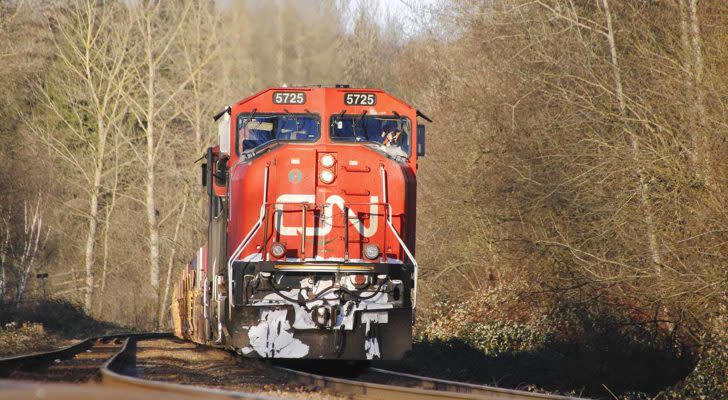Ticking Time Bombs: 3 Transportation Stocks to Dump Before the Damage Is Done
While up on the year, transportation stocks continue to trail the market. The S&P Transportation Index is up 10% in 2023, but over five years, the index is up only 12%. Railways, trucking companies, airlines, and shipping firms continue to make the global economy run but can’t seem to gain any traction with investors. And yet, the transportation sector remains a major engine of the U.S. economy, valued at $1.36 trillion and employing more than 10 million people in jobs ranging from truck drivers to warehouse workers and stevedores.
The reasons for a lack of investor interest range from rising concerns about input costs fueled by inflation to slow growth compared to high-flying technology. Not to mention the uncertainty around a global economy that many economists expect to enter a recession in 2024.
The result? A run of ticking time bombs. Here are three transportation stocks to dump before the damage is done.
InvestorPlace - Stock Market News, Stock Advice & Trading Tips
Canadian National Railway (CNI)

Source: Eric Buermeyer / Shutterstock.com
Railways can be great investments, but the Canadian National Railway (NYSE:CNI), the largest in the country, has been challenged lately. It reported that its second-quarter net income, or profit, fell 12% to $1.17 billion from $1.33 billion a year earlier. The rail operator’s Q2 revenue declined 7% to $4.06 billion from $4.34 billion in the same period of 2022.
Worse, Canadian National lowered its forward guidance for the remainder of this year, saying it now expects flat to slightly negative earnings for all of 2023 instead of previous estimates calling for mid to single digit growth. The company blamed the poor Q2 results and lowered guidance on a slowing North American economy. Canadian National is also contending with disruptions caused by runaway wildfires and the fallout from a strike at West Coast ports this July which halted freight shipments for several weeks.
CNI stock has declined 7% year to date but is up 23% over five years.
Southwest Airlines (LUV)

Source: Eliyahu Yosef Parypa / Shutterstock.com
Southwest Airlines (NYSE:LUV) is the laggard among U.S. airlines coming out of the Covid-19 pandemic. LUV stock is down 18% this year and has declined 57% over the last five years. The airline’s stock shares are currently trading at a 52-week low.
The share price depreciation comes after the carrier was grounded during the Covid-19 crisis, suffered a major meltdown of its entire system last year during the busy holiday travel season, and narrowly avoided a strike by its more than 10,000 unionized pilots this spring.
The sharp drop in LUV stock also comes after the carrier reported a string of underwhelming earnings reports. Southwest’s share price plunged more than 10% after the company issued its latest quarterly print at the end of July. Analysts and investors didn’t like that the airline’s costs are rising, with its operating expenses for this year’s second quarter increasing 12.1% compared with a year earlier.
The consensus is that Southwest has failed to take advantage of the surge in travel demand that’s taking place right now.
Canadian Pacific Kansas City (CP)

Source: Shutterstock
Newly merged railway operator Canadian Pacific Kansas City (NYSE:CP) has long-term potential, but it has some issues right now that make it a risky investment.
In addition to a slowing continental economy, wildfires, and port strikes, the railway company is also in the process of sorting itself out after Canadian Pacific acquired Kansas City Southern for $31 billion, creating the only railway that covers all of North America, from Canada through the U.S. and into Mexico. Finalizing the merger internally remains the company’s top priority.
While the first earnings report was promising with net income of $1.33 billion, up 74% from a year earlier before the merger took place, there were nevertheless some troubling signs. Canadian Pacific Kansas City said that the West Coast port strike will likely cost it $80 million in lost revenue for Q3. Additionally, the company said that during the second quarter of this year, its container traffic fell 10% from a year earlier.
CP stock is flat year to date, down 0.64%.
On the date of publication, Joel Baglole did not have (either directly or indirectly) any positions in the securities mentioned in this article. The opinions expressed in this article are those of the writer, subject to the InvestorPlace.com Publishing Guidelines.
Joel Baglole has been a business journalist for 20 years. He spent five years as a staff reporter at The Wall Street Journal, and has also written for The Washington Post and Toronto Star newspapers, as well as financial websites such as The Motley Fool and Investopedia.
More From InvestorPlace
ChatGPT IPO Could Shock the World, Make This Move Before the Announcement
Musk’s “Project Omega” May Be Set to Mint New Millionaires. Here’s How to Get In.
The Rich Use This Income Secret (NOT Dividends) Far More Than Regular Investors
The post Ticking Time Bombs: 3 Transportation Stocks to Dump Before the Damage Is Done appeared first on InvestorPlace.
